
Asus ROG Swift PG259QN Review: Hitting 360Hz
by Tim SchiesserThe Asus ROG Swift PG259QN is the first monitor to hit a 360Hz refresh rate, giving us motion clarity that’s unlike anything we’ve seen with LCD panels before. It also presents the next evolution of high refresh rate monitors, moving significantly beyond the 240Hz barrier that we’ve become accustomed to over the past few years.
What’s perhaps more exciting about the Asus PG259QN is that it hits this refresh with an IPS panel, not a TN. This is the first time that IPS is offering the fastest refresh rates on the market, historically that’s been the realm of TN panels and the only key selling point to those displays.
With this new 360Hz IPS and other ultra fast monitors like Samsung’s VA-based Odyssey G7, it feels like TN is on its last legs as other technologies step up to do what TN has done, but better.
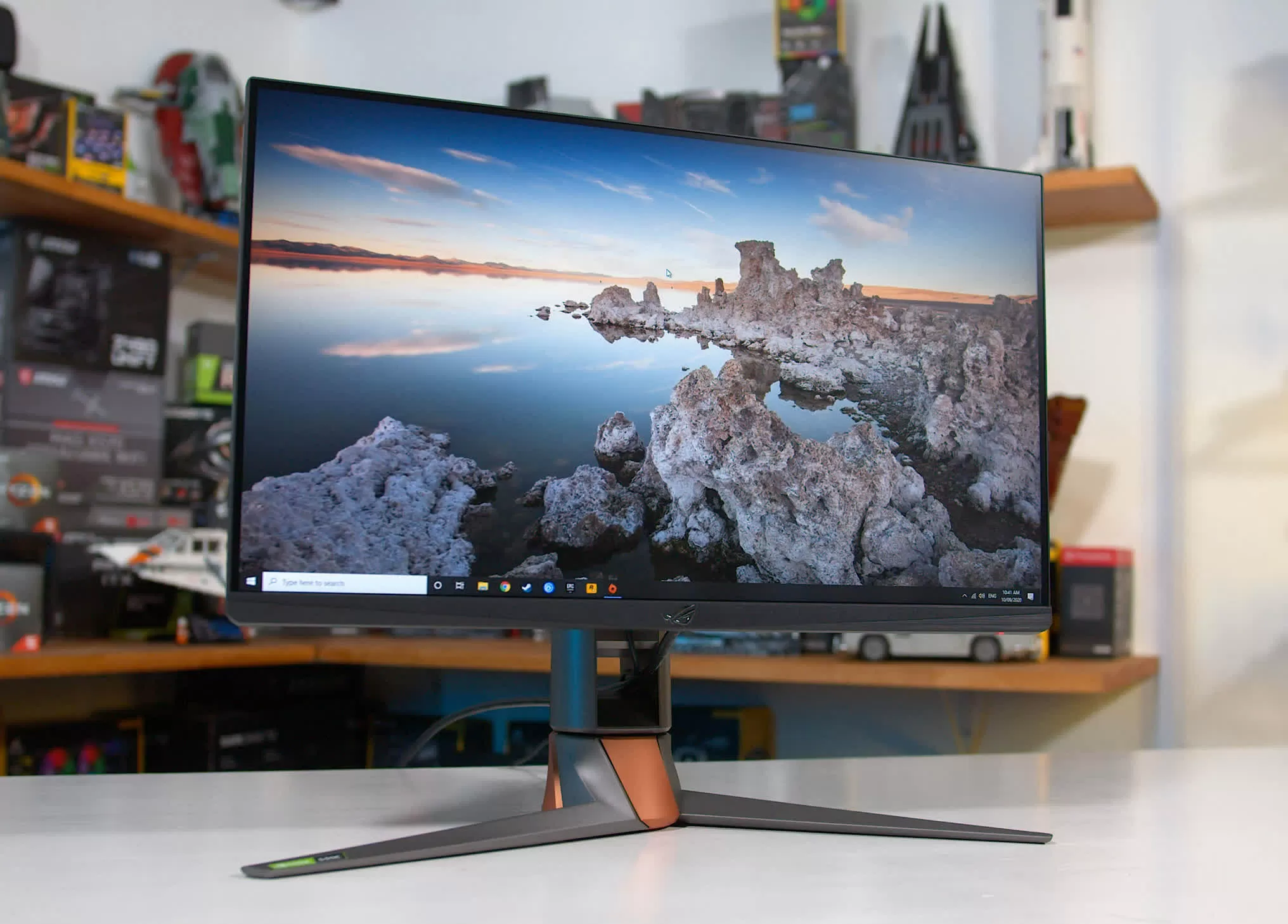
Now, a 360Hz monitor isn’t going to be for everyone, especially as we’re seeing just a 1920 x 1080 resolution and 24.5-inch size. But this review presents an interesting look into where monitor technology is headed and what we can expect from other high-end displays over the coming years.
As for other key specifications, the PG259QN is a G-Sync monitor, using a full G-Sync module for its adaptive sync functionality. This ROG monitor has been key to Nvidia’s “Frames Win Games” marketing campaign and has been hyped up alongside their new RTX 30 series GPUs. But this is not an Nvidia-exclusive product, the new iteration of their G-Sync module features industry standard adaptive sync support, so the PG259QN also works with variable refresh rates on AMD GPUs and other VRR-enabled devices.
We are now beyond the point where G-Sync is a locked down technology and that’s great to see. Oh and it’s a passively cooled G-Sync module, so no need to worry about fan noise like with some G-Sync Ultimate displays.
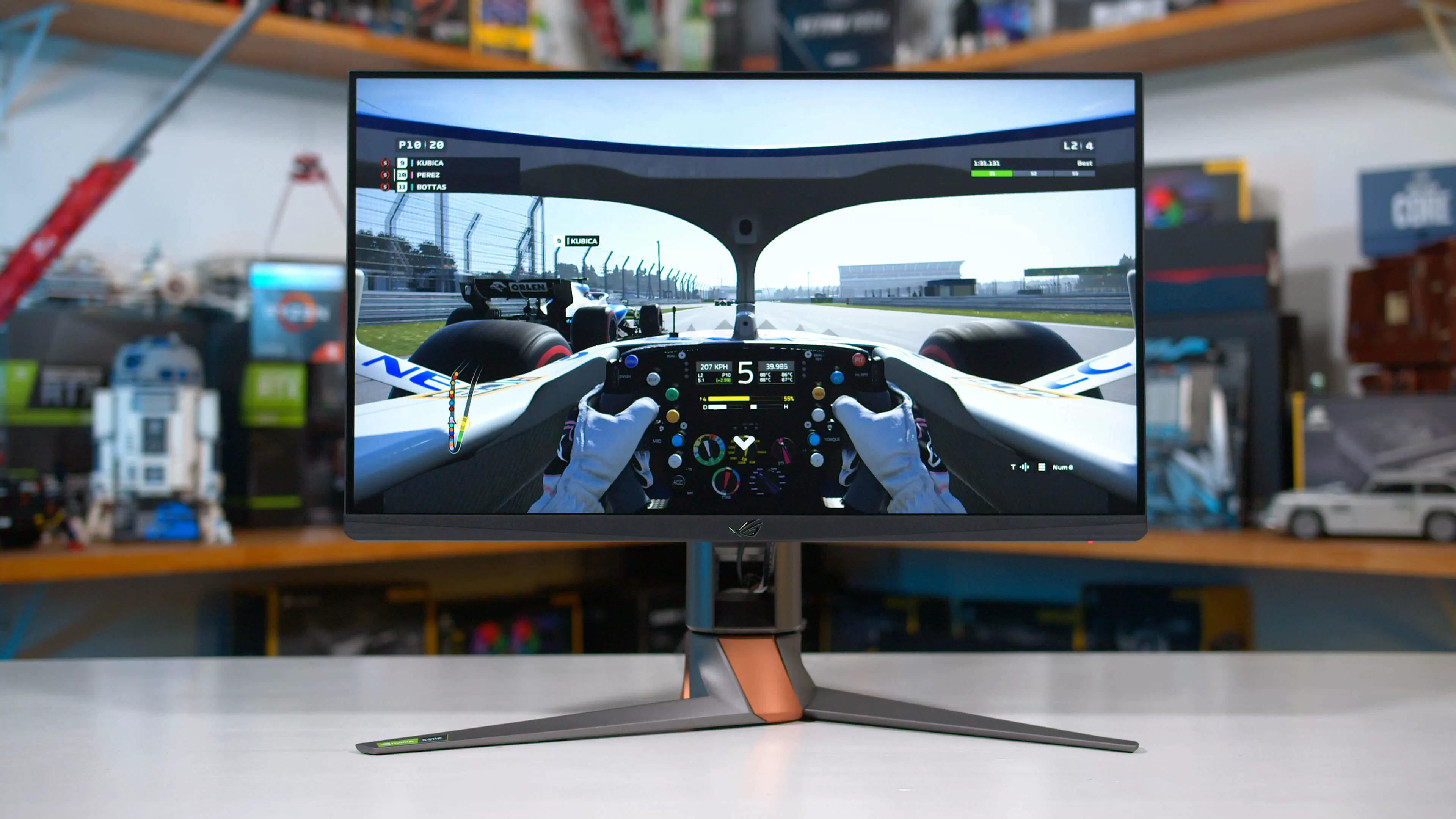
Asus advertises the display as HDR capable but there’s no local dimming support so realistically, this is not an HDR monitor. There’s not even a wide color gamut. But that’s not important for a super high refresh display, this is all about that 360Hz refresh rate, fast IPS technology, 1ms grey to grey response time and so on.
Like most of Asus’ ROG monitors, this one is designed with the “gamer” crowd in mind. There are a lot of gamer style elements to be seen here, from the sharp patterns on the rear, to the RGB LEDs, to the bold and aggressive stand. We’ve said a few times in the past that we don’t like Asus’ ROG design aesthetic and that’s no different here, this is not my favorite monitor design.
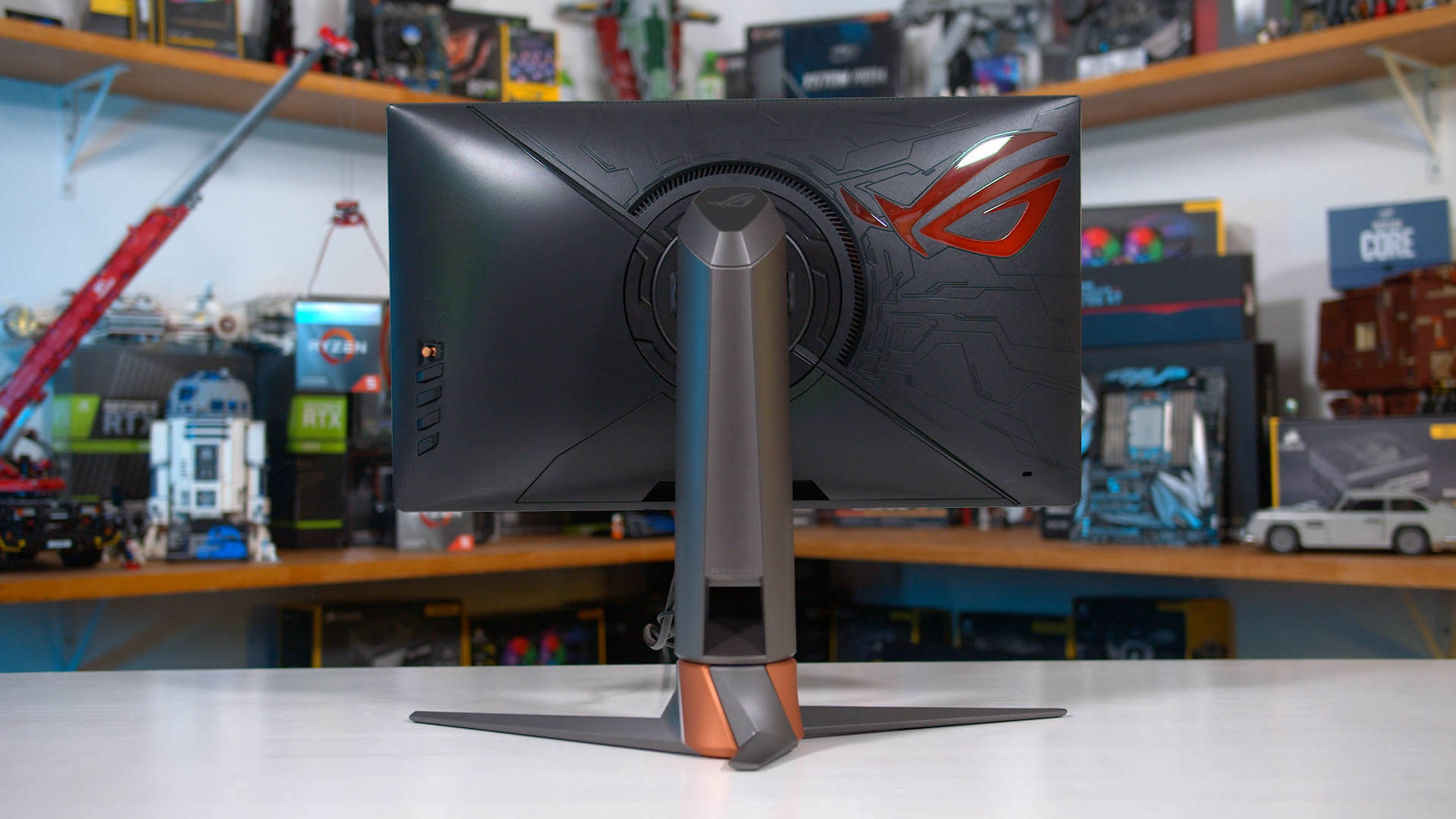
With that said, Asus has undeniably built this monitor well. The stand uses a premium metal construction for its legs, and while the rest of the display is mostly plastic, we’re getting slim bezels, no visible seams and a sturdy stand. Despite packing a full range of motion including height adjustment and pivot support, the PG259QN is rock solid and will easily cop a bump to your desk without moving at all.
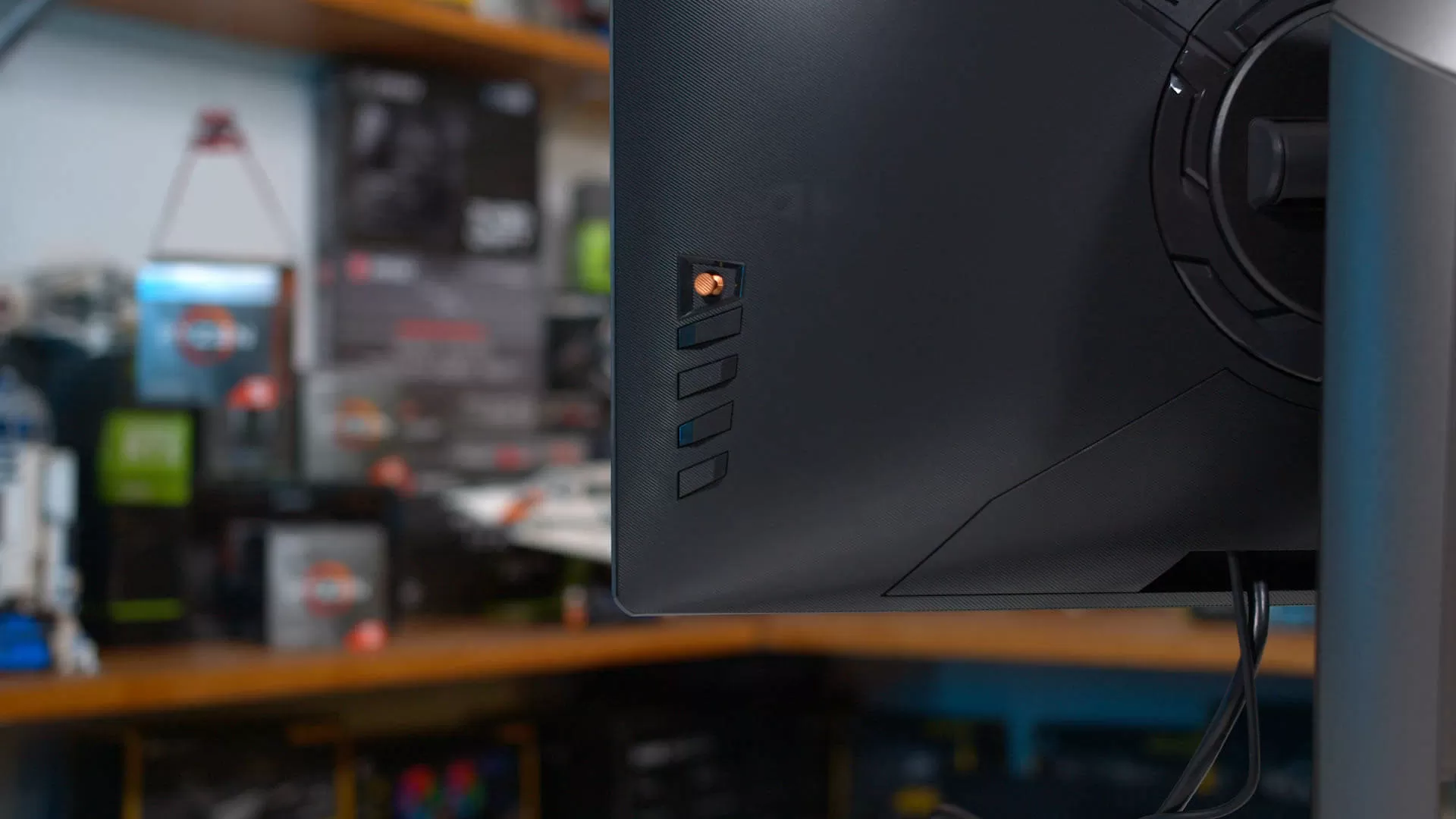
The on screen display is controlled through a directional toggle and we get the usual strong set of Asus features. For gamers, this includes timers, crosshairs, FPS counters and display alignment tools, all of which are useful. There’s also shadow boosting and blue light filters for manipulating colors. And then a healthy array of color controls to nail down color accuracy.
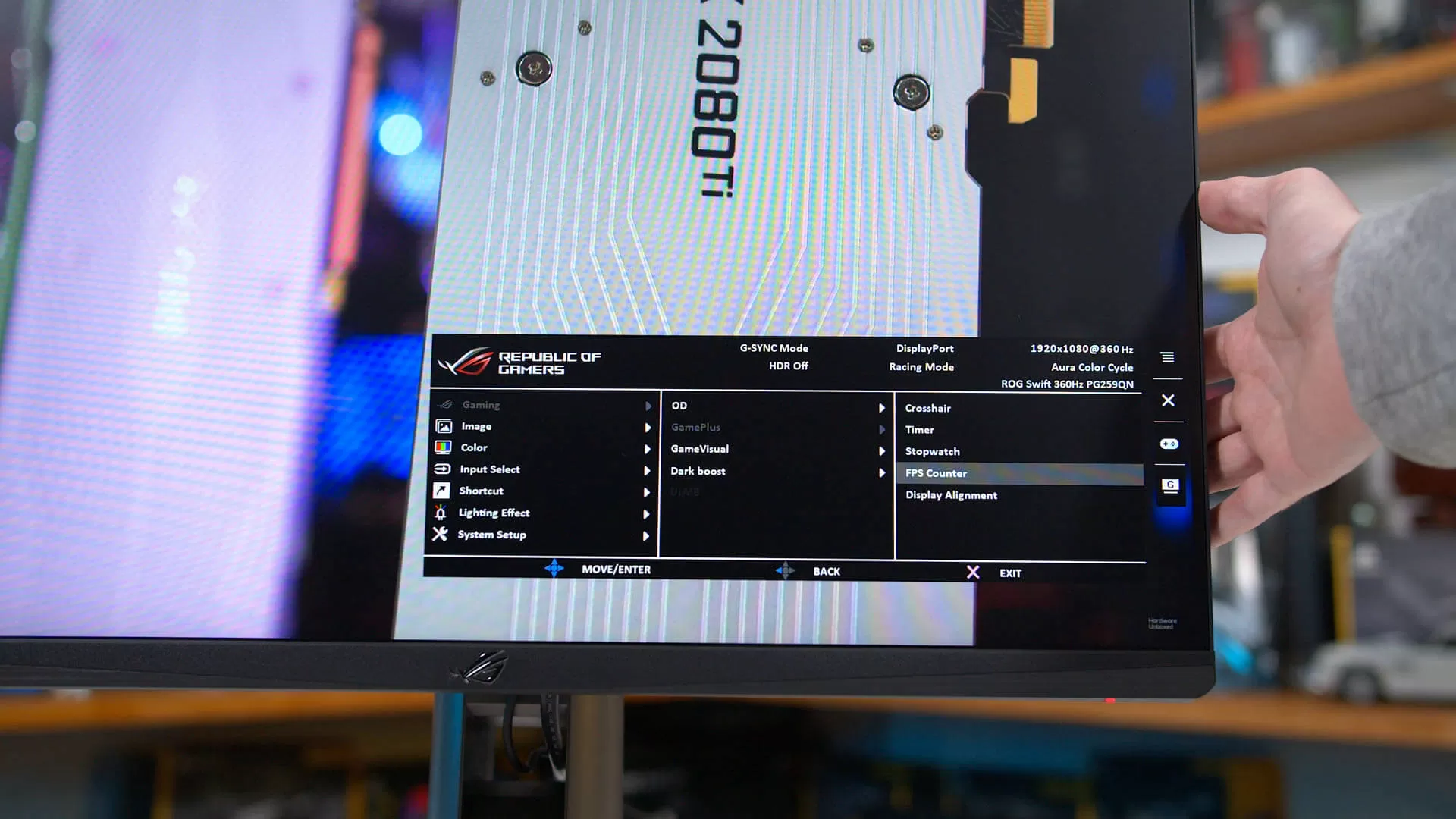
The selection of ports is fine although for some it may be a little lacking: there’s a single DisplayPort, and single HDMI port, in keeping with other G-Sync displays. You’ll need to use DisplayPort if you want to access the 360Hz refresh rate, HDMI is capped to 240Hz. There’s also a two-port USB hub and an audio output jack. No built-in speakers on this one.
One of the big questions we had going into this review was: is 360Hz actually better than 240Hz? There’s already been a lot of discussion about how 240Hz delivers diminishing returns over 144Hz, so what’s the situation here with another step up in refresh rate?
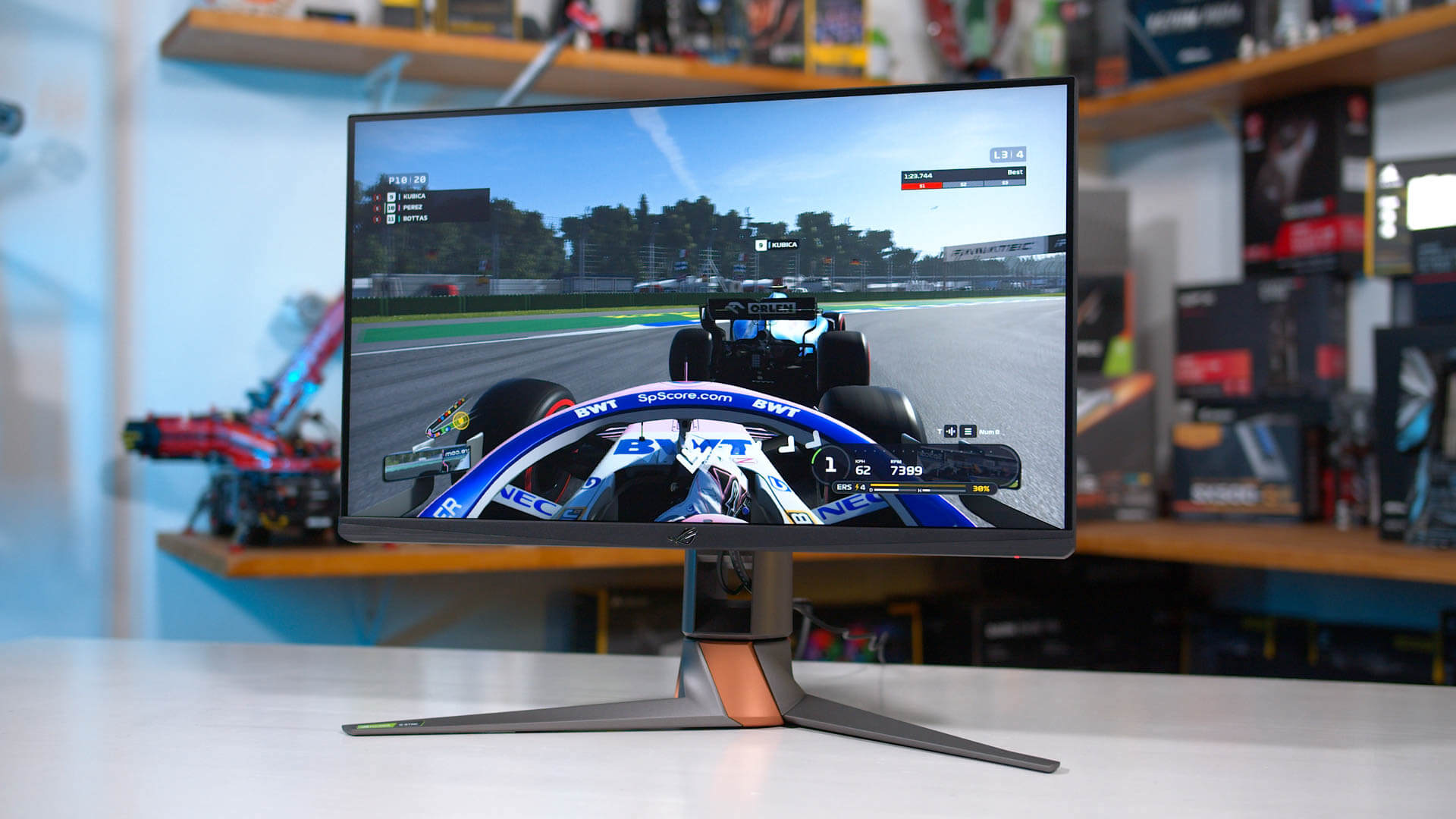
Display Performance
Response Times / Overdrive Modes
To be honest, we think the experience will vary from person to person as to whether the difference from 240Hz to 360Hz is noticeable. To me, I can notice a small but perceptible gain on 240Hz, and even without a side-by-side comparison I was pleasantly surprised with how responsive this display feels to use.
It’s extremely fast, input feels lightning quick and I’m not a professional esports gamer, although as a monitor reviewer I am tuned in to spotting differences in visual quality. If you’re less sensitive, maybe you struggle to tell the difference between 60 and 144 Hz (and yes, there are those people out there), then yeah, 360Hz will be wasted on you.
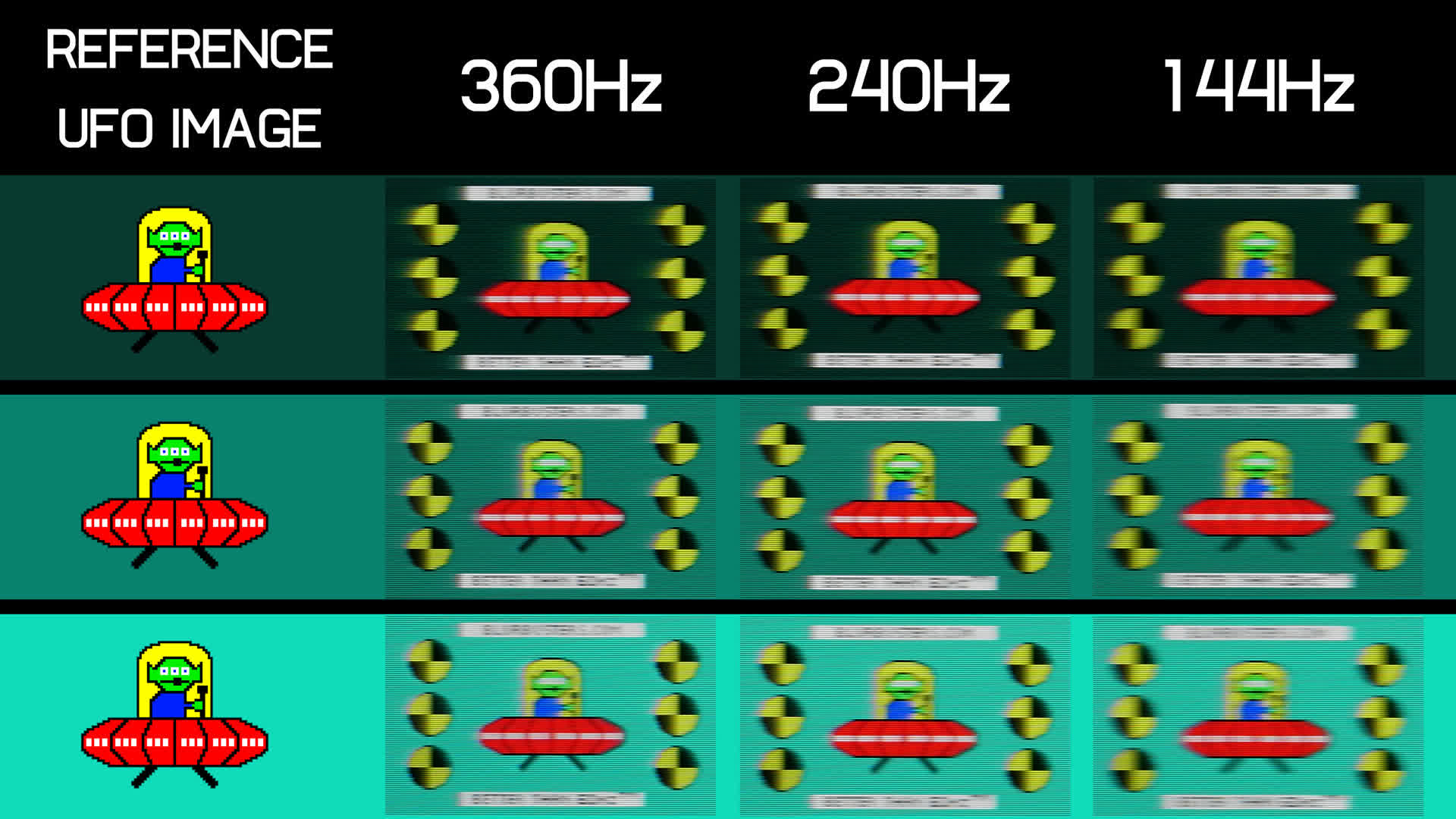
What is very obvious though, is how much of an upgrade 360Hz is on 144Hz. During this review I used the PG259QN side by side with my daily driver, the LG 34GK950F with its 144Hz refresh rate. 144Hz feels sluggish and slow in comparison to 360Hz, there’s a clear difference in smoothness as you’d hope for with a 2.5x increase to the refresh rate.
It’s not as stark of an improvement as 144Hz is on 60Hz (a 2.4x increase to refresh rate), but if you’ve been using 360Hz for a while then go back to something merely 144Hz, you can feel the difference. With 240Hz you get some of this effect, but not to the same extent as with 360Hz.
The next question is whether an IPS panel can keep up with the demands of a 360Hz refresh rate; the window for each refresh here is just 2.78ms, in other words, the monitor can display a new image every 2.78ms. To get a true 360Hz experience, the panel has to be capable of finishing its transition before this window expires, otherwise you just get a smeared mess.
Asus ROG Swift PG259QN - 360Hz (off)

There are just three overdrive modes provided, the first of which is the Off mode. While a sub-6ms average transition time is impressive for an IPS panel, it’s not fast enough for 360Hz gaming. But I don’t think many people will choose to use this mode, given it’s not the default.
Asus ROG Swift PG259QN - 360Hz (normal)

The default Normal mode gets you extremely impressive performance. With a 2.21ms grey to grey average, we are well within the ballpark of a true 360Hz experience. In effect, we see two thirds of all transitions completing within the 2.78ms refresh window, and over 90% within a reasonable tolerance of the window. This helps to deliver excellent motion clarity with no smearing, very impressive for an IPS display.
There is a small amount of overshoot but in practice this is not noticeable, average error rates of 4% are well within normal tolerances so overall, no issues here at all with how this display performs at 360Hz. To answer the initial question, it seems this new “Fast IPS” technology from AU Optronics is absolutely capable of 360Hz refresh rates. We’re getting TN equivalent performance so don’t worry at all about IPS not keeping up with such a high refresh, it absolutely can.
Asus ROG Swift PG259QN - 360Hz (extreme)

The extreme mode, one step higher, isn’t as useful. Here we get very high levels of overshoot and grey to grey performance doesn’t improve significantly on average. Given that in this mode as well as the Normal mode, we do see 1ms transition times or lower, I think Asus’ claims about a 1ms grey to grey transition are largely accurate. We still aren’t at a point where we get 1ms on average, but 2ms is pretty close, so we’re definitely inching closer.
Asus ROG Swift PG259QN - 360Hz, 240Hz, 144Hz, 60Hz (normal)




When using the Normal mode, there’s no need to worry about switching to other overdrive modes at different refresh rates. Thanks to the G-Sync module’s implementation of variable overdrive, we get solid performance throughout the entire refresh range.
At 240Hz we see a 2.59ms grey to grey average with a small increase to overshoot. At 144Hz we’re now at a 3.3ms average with higher but manageable overshoot. Then at 60Hz we retain manageable overshoot with an increase to a 4.39ms transition time average. All throughout this range performance is really good and that’s what I’d expect from a high end monitor.

In offering nearly a 2ms grey to grey average, the Asus PG259QN is the fastest monitor we’ve ever tested.
It’s the fastest in terms of refresh rate, but also in terms of response times, the two go hand in hand here to top the charts. This monitor is about 17% faster in terms of response times than the next best, the LG 27GK750F, at lower levels of overshoot. We’re also seeing 40% faster responses than other TN monitors we’ve tested, like the HP Omen X 27, when viewing maximum performance.
The only other monitor that gets close is Samsung’s Odyssey G7, another sub-3ms contender albeit with a lower 240Hz refresh rate. While Samsung is undoubtedly getting excellent performance out of a VA panel, IPS is still the faster technology overall and more suited to ultra high refresh rates like 360Hz. The fact it’s beating TN is even more impressive, thanks to a 50% performance gain over previous generation IPS display which topped out at 280Hz refresh rates.

This chart is a recent addition to our monitor reviews, and shows average performance across the entire refresh range, when using the best overdrive mode for variable refresh rate gaming. Previous charts showed best performance at the highest refresh rate, this chart is average performance across all refresh rates tested. Due to the PG259QN falling off slightly at lower refresh rates compared to other monitors, the PG259QN doesn’t hold the kind of lead it did in the maximum performance chart. But it’s still the fastest display overall by a narrow margin, although with somewhat higher inverse ghosting rates.
In general though, all three of the monitors at the top of these charts offer a remarkable gaming experience. The PG259QN does it with IPS, the HP Omen X 27 does it with TN, and the Samsung Odyssey G7 does it with VA. Overall, the ROG PG259QN is the faster monitor due to its higher refresh rate, but it’s great to see such strong competition between different technologies, something we’ve never seen until now.


Dark level performance is a non issue with the PG259QN, there’s no dark level smearing and response times are consistent across the board. Then for refresh rate compliance, 90% is good enough for a mid-table result and that’s certainly excellent for an IPS display. We’re seeing all of this achieved with a sub-5% average error rate, which indicates the panel isn’t being pushed to the extreme to deliver high response times.

60Hz really isn’t the best showcase of what this monitor can do, but performance is solid nonetheless, with a 4.39ms grey to grey average. Not quite up there with the best TN panels, but realistically the experience will be similar given the high level of blur you get at 60Hz anyway.

Input lag is excellent with this display. Processing delay is around 0.2ms which is elite, and when combined with a very high refresh rate and quick response times, we end up with a sub 4ms input to image delay. The PG259QN feels lightning quick to use and this is why, we see class leading input latency which allows for a very smooth and responsive experience.

Power consumption is on the high side for a 24.5-inch display, although the inclusion of a G-Sync module and high refresh rate will impact that somewhat. Still, 30W is nothing crazy and no cause for concern.
The PG259QN also supports ULMB, aka Ultra Low Motion Blur, which is Nvidia’s brand name for backlight strobing technology to reduce blur. It’s interesting that it’s called ULMB here instead of Asus’ usual brand name ELMB, probably due to the G-Sync arrangement. There’s also no ELMB-Sync here, so this display only supports backlight strobing at fixed refresh rates and with G-Sync disabled.
There are further restrictions to how ULMB can be used though. The big one is it can’t be activated at 360Hz, the maximum refresh rate for ULMB is 240Hz. 360Hz has excellent motion clarity so at that refresh rate it probably would have only delivered a minor improvement, but still, it’s disappointing to see no possible combination of max refresh and ULMB.

At 240Hz, ULMB is good, however there is a faint-to-moderate double image from strobe crosstalk. In my opinion it’s actually a bit clearer at 144Hz, although the strobe is more obvious here and you do lose the smoothness of additional frames. Neither of these refresh rates deliver a perfect backlight strobing experience, and given ULMB is limited to fixed refresh rates, it’s also not an ideal situation. I’d prefer to use the monitor in its maximum 360Hz mode with G-Sync, but ULMB might be an option in some scenarios.
Default Color Performance
Asus ROG Swift PG259QN - sRGB, tested at native resolution, highest refresh rate
Portrait CALMAN Ultimate, DeltaE Value Target: Below 2.0, CCT Target: 6500K
Grayscale, Saturation and ColorChecker

Moving into color performance, and this should be a relatively quick section... that’s because Asus has delivered near-perfect factory calibration with this monitor. Not only are response times the fastest we’ve tested, but the level of calibration delivered out the box is the best we’ve seen from any gaming monitor.
The best aspect to calibration here is perfect adherence to the sRGB gamma curve. And I mean perfect, seriously this is flawless performance. The CCT curve is also excellent, with no appreciable tint from the factory. This leads to outstanding deltaE averages below 1.0 by default, this cannot be improved upon in a meaningful way with further calibration.


Saturation performance is also very good. The top end is impacted a small amount, but the rest of the range delivers good performance. A deltaE 2000 average below 1.0 is elite, and deITP performance is also great. Then in ColorChecker, again outstanding results here, equivalent to the previous best calibrated monitor we’ve tested, the Acer Predator X27. On average, monitors in their factory state achieve a deltaE 2000 average of 3.34 in this test, so sitting well below that at just 0.55 is as good as it gets.
OSD Tweaked Color Performance
Asus ROG Swift PG259QN - sRGB, tested at native resolution, highest refresh rate
Portrait CALMAN Ultimate, DeltaE Value Target: Below 2.0, CCT Target: 6500K
Grayscale, Saturation and ColorChecker
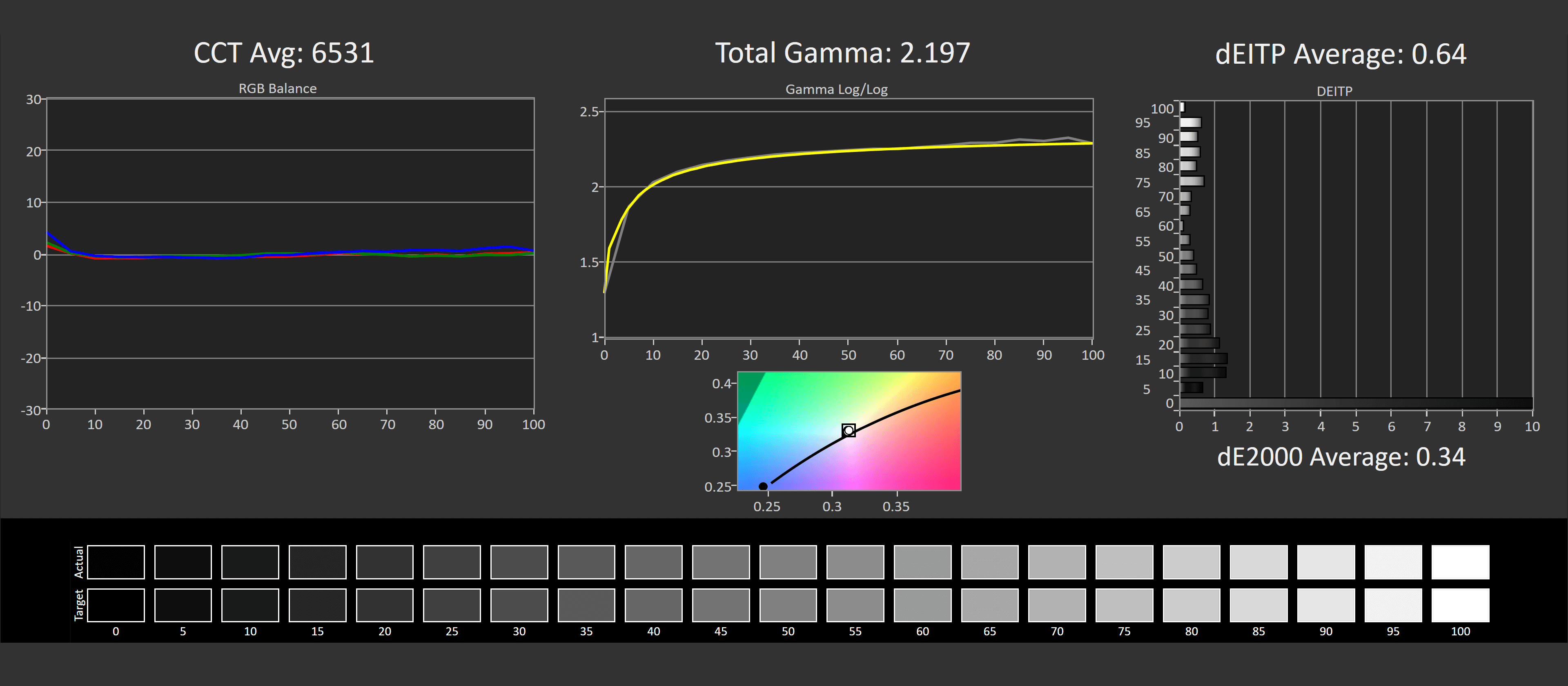
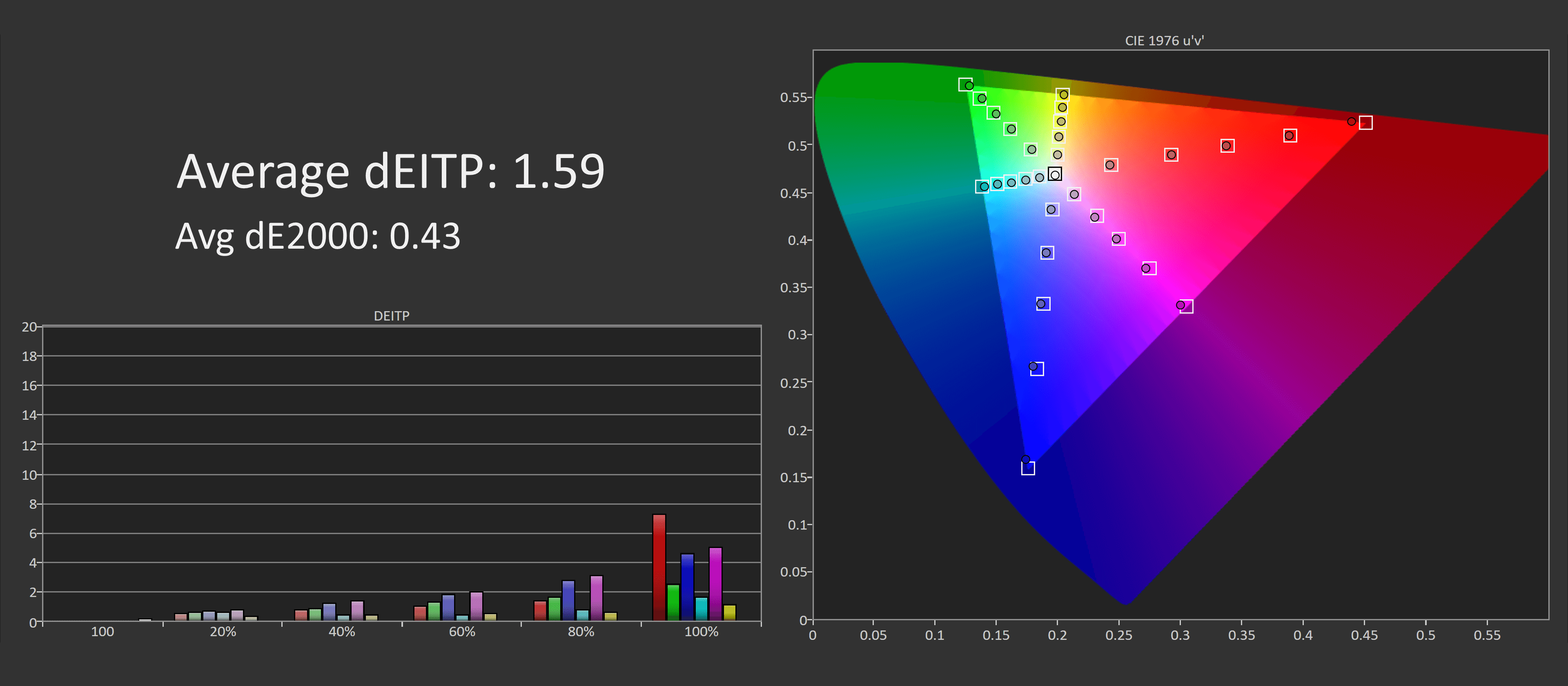
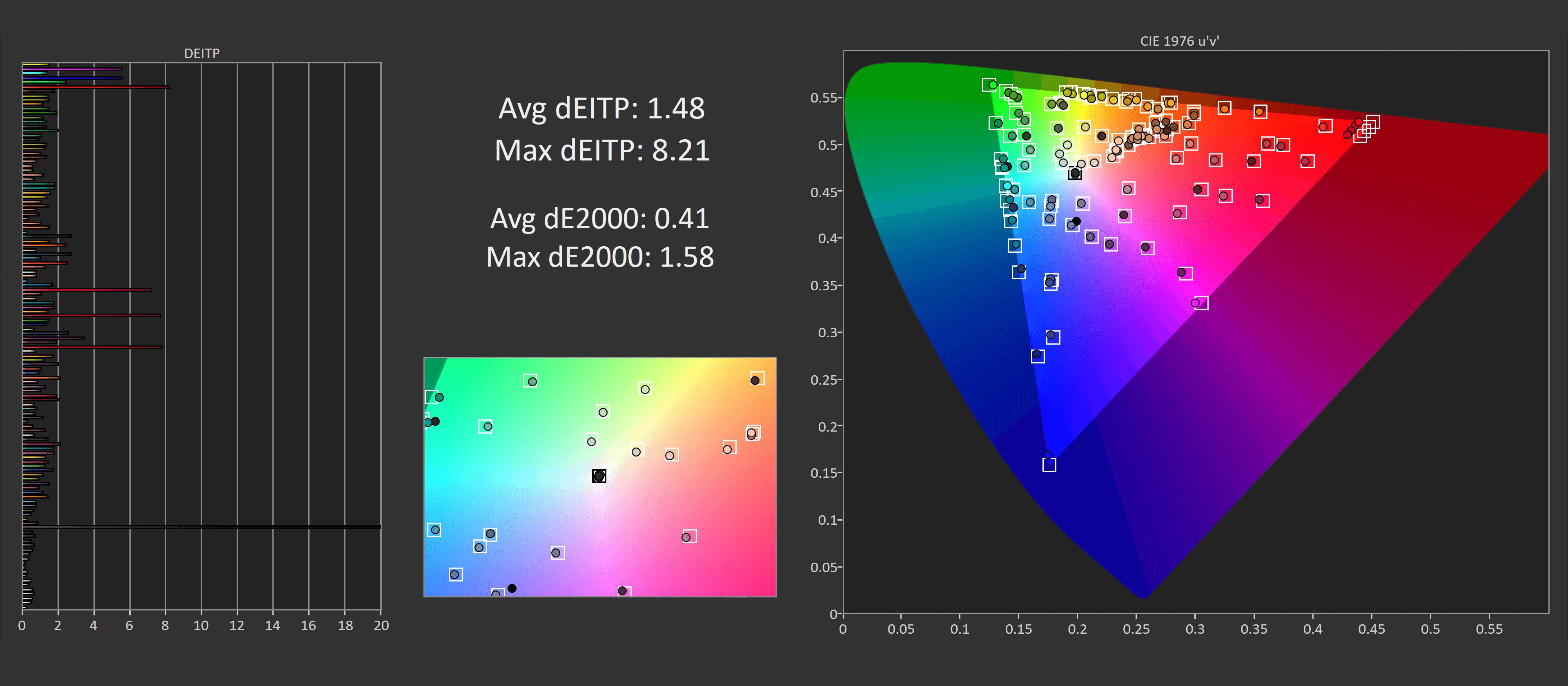
The only way we were able to improve performance further is with a few very minor tweaks to the OSD but even then, we don’t think it’s worth showing our settings as we're confident the best choice would be different for different units. In our opinion the factory calibration is good enough that you can use this out of the box with no changes at all. That’s excellent for this sort of monitor, well above our expectations.
Color Space: Asus ROG Swift PG259QN - D65-P3

There’s only one downside here, and that’s the total sRGB color space, which sits at just 95%. That’s not terrible, but it’s a little short of the 100% we’d like to see from modern sRGB displays.
The main culprit is that reds are a small amount below where they need to be. Honestly this is not a major issue for most people, 95% is absolutely fine, but it’s just something to be aware about.
Brightness, Contrast, Uniformity

The PG259QN delivers very high levels of brightness in SDR mode, at over 500 nits. While it’s not practical to use the monitor at 500 nits in most environments, it does allow the backlight strobing mode to also deliver a high level of brightness, so it’s not a wasted feature.

What’s really encouraging to see is the PG259QN delivering a strong contrast ratio for an IPS display. Previous fast IPS panels like those from LG, sacrificed contrast to achieve fast response times. Given IPS panels normally have better contrast and color quality than TNs, this trade off was a bit disappointing for buyers and while there were still other areas where LG’s IPS produced much better image quality than a TN, black levels were weak.
AU Optronics with this panel has made no such trade-off, you’re getting a 1200:1 contrast ratio which is a bit above an average IPS. This gives AUO the #1 spot for IPS technology and we're quite eager to see similar implementations in other sizes and resolutions.
Of course, like with all IPS monitors, contrast isn’t amazing overall as an VA panel will offer around twice the performance or better. But given what we’re working with and the response times on offer, we’ll take 1200:1 every day.
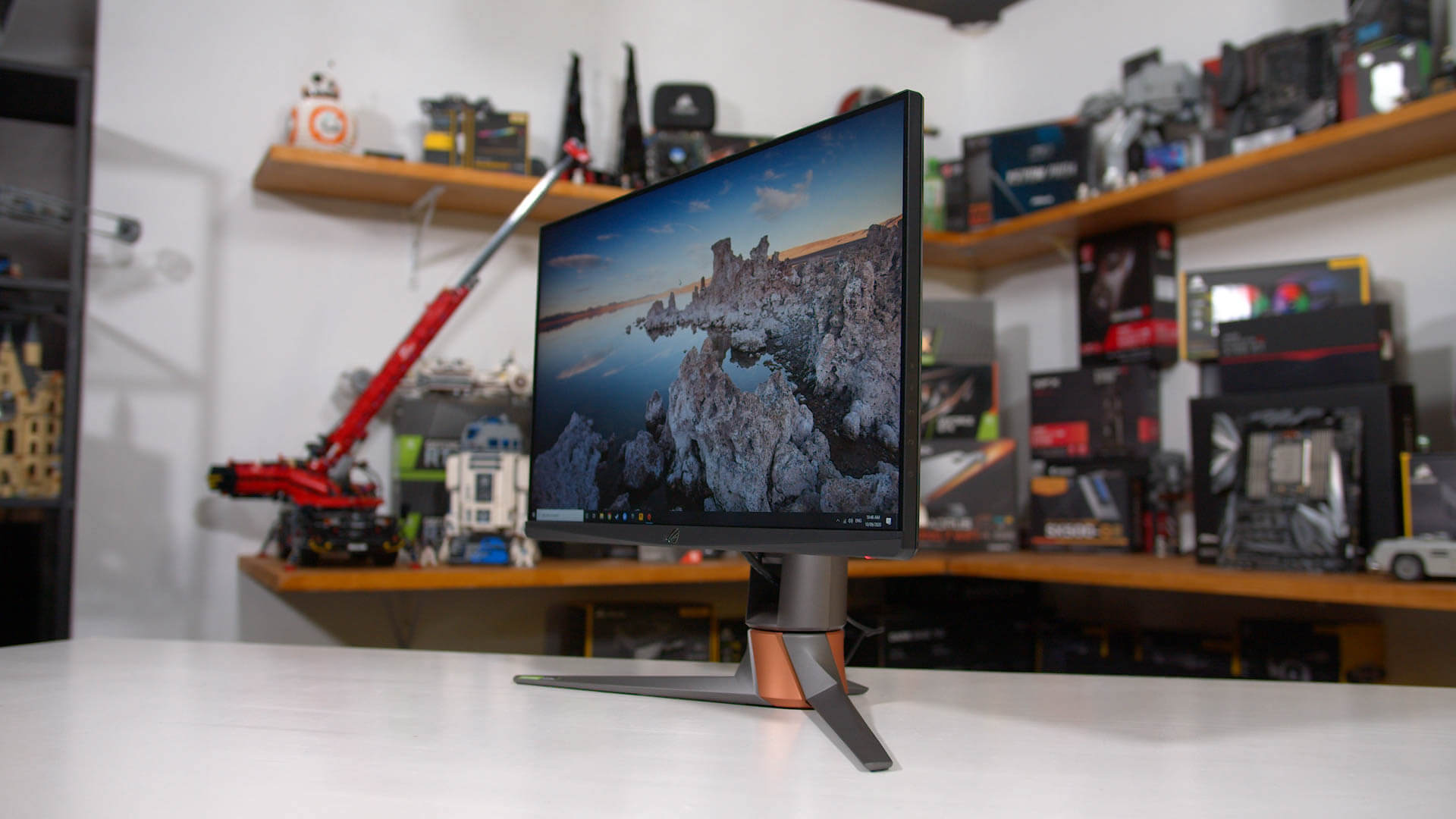
Viewing angles are great, similar to other IPS monitors and obviously far better than what a TN can provide. This means you don’t need to view the PG259QN dead on to get the clearest image, if you’re viewing it at a slightly off angle, everything is still very clear.
This may not be a big deal for everyone, but I genuinely think this is important for tournament-level gaming because there’s much more leeway for viewing the screen at various angles without a loss to image quality. Every little advantage counts.


Uniformity shows average results with a small difference between the left and right halves in terms of color tint, not a huge deal but after a series of excellent performance results this is probably one of the display’s weaker areas. We don’t think this is a bad result though, and our unit didn’t suffer from IPS glow so that’s a positive.
What We Learned
With all the testing results in, we're very impressed with the Asus ROG Swift PG259QN. From a performance perspective, this is an absolutely fantastic display that nails everything it sets out to achieve.
The headline feature is superb response times, allowing for a true 360Hz experience, with an IPS panel. This sort of performance was unheard of a few years ago, but it’s totally possible and Asus is delivering in a big way.
Asus is claiming this is the world’s fastest esports gaming monitor and we'd absolutely agree with that statement based on our testing. This is the highest refresh rate display we’ve used, and it has the fastest overall response times. That’s a killer combination for competitive gaming, and when you throw in variable overdrive that keeps performance great throughout the entire refresh range, it’s hard to fault any aspect to the gaming experience.
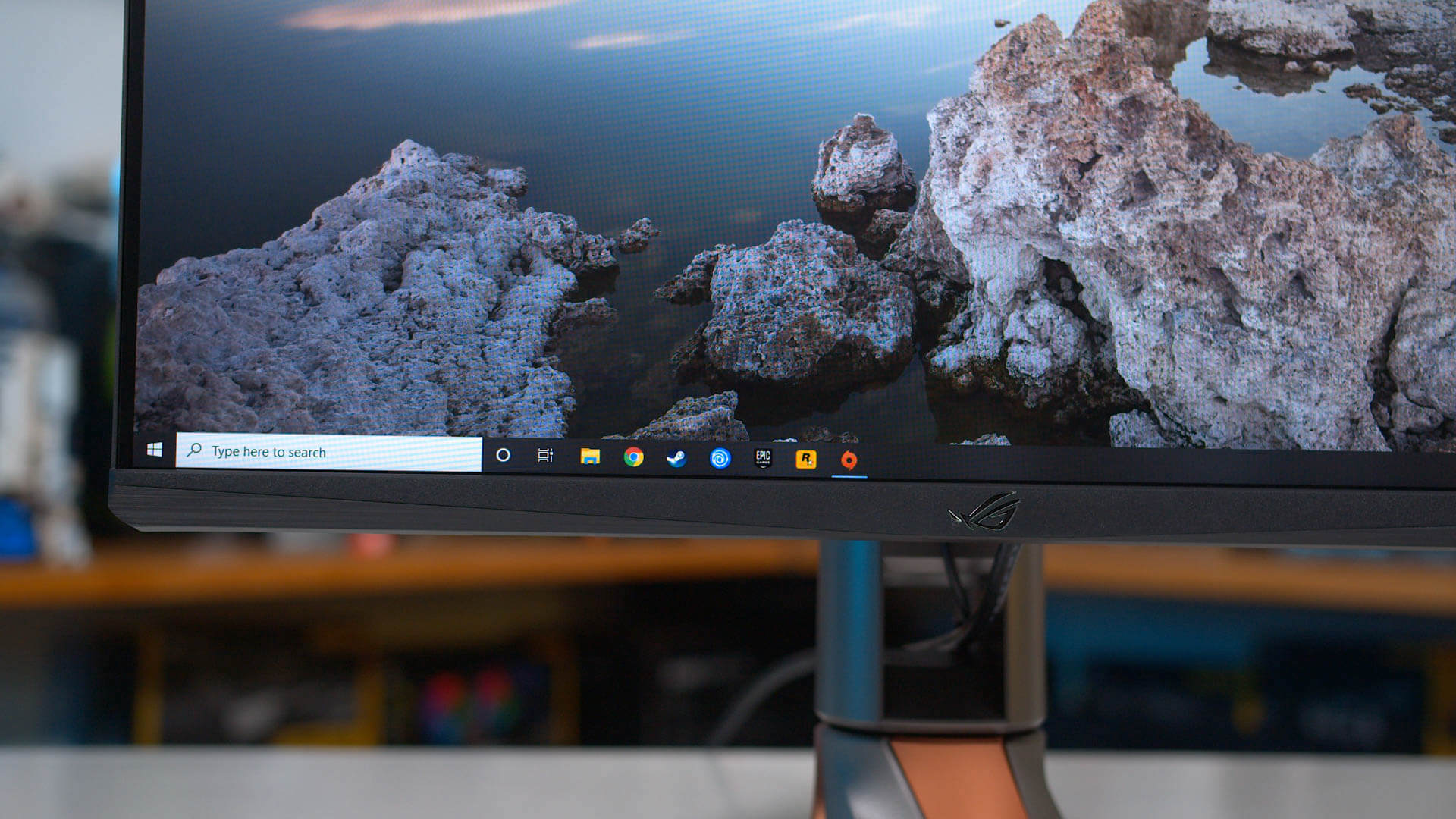
Another surprising feat is how Asus has backed up elite response times with the best factory calibration we’ve seen from a gaming monitor. There’s no need to mess around with display settings, you can just plug in the monitor and get gaming with excellent colors. So it’s a one-two punch: the fastest response times and the most accurate color experience. That will be extremely hard to beat.
Contrast, unlike LG’s fast IPS monitors, is great so there’s been no trade-off to achieve great performance. Brightness is superb, as are viewing angles, so when combined with accurate colors, the image quality here is awesome. If I had to nitpick, the backlight strobing mode could be better, and we’re not quite hitting 100% sRGB coverage. That’s about all we can think of.

Then again, as awesome as the ROG Swift PG259QN is and the performance it can deliver, we don’t think this monitor will be for everyone, but a smaller niche of players. For most people, let alone casual gamers, 360Hz is only going to offer a minor improvement over 240Hz. It is better, but for an average gamer, it’s probably not that much better.
There’s also the question mark over whether you will even be playing at the required frame rate, given you’ll need a very powerful system and to be playing less graphically intense esports titles like CS: GO or Rainbow Six Siege.
In terms of pricing, $700 is a lot of money to pay for a 24.5-inch 1080p display, and almost twice the price of the MSI MAG251RX, a great quality 1080p 240Hz IPS monitor we reviewed a few months ago. Spending $700 on a monitor that provides only a minor upgrade for most people over a $360 monitor is not a great value choice, even though the $700 option has outstanding performance.
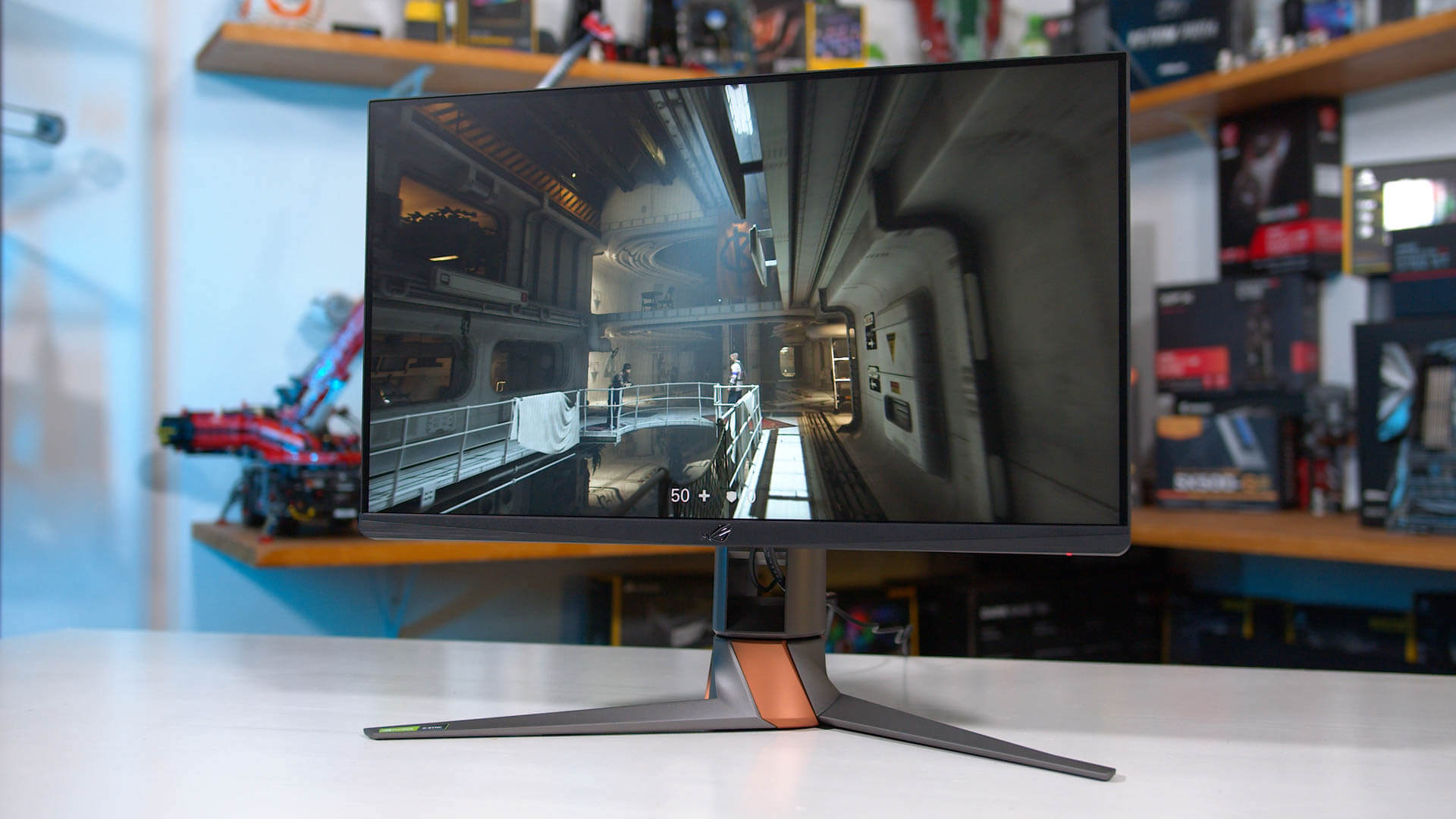
If speed isn’t absolutely everything to you, then $700 can get you an awesome monitor experience with benefits in other areas. You could buy the Samsung Odyssey G7 with its 1440p 240Hz VA panel. Or a nice 4K 144Hz display. Or an LG 27GL850 and save a bit of cash. For most people and especially those that don’t just play esports titles, I’d probably choose one of those options.
Then again, average buyers are not the target market for this monitor. This is for professional gamers, those that play in tournaments and do serious competitive gaming. Having that performance edge over a 240Hz display, no matter how minor, could be the difference between winning or losing.
For that audience, the Asus ROG Swift PG259QN is an outstanding display. Higher refresh rate than we’ve seen before. Best response times for the clearest motion. G-Sync variable overdrive. IPS display with excellent viewing angles. Elite factory calibration. Spending $700 to get a competitive advantage over your fellow gamers in a money-on-the-line setting is chump change, the only thing that matters is whether the hardware is actually good and does actually provide an advantage. And this monitor is more than just “good”.
The PG259QN also gives us a look into the future of monitor technology. While 360Hz displays at 1080p might be out of reach for most buyers today, continual innovation at the high-end ripples through the rest of the market. 240Hz displays will get cheaper and better. IPS monitors will get faster. In a few years, specs like these will be more affordable as new stuff is introduced at the top. That’s what we love to see and the performance on offer with the PG259QN has me excited for the next few generations of monitors across the entire ecosystem.